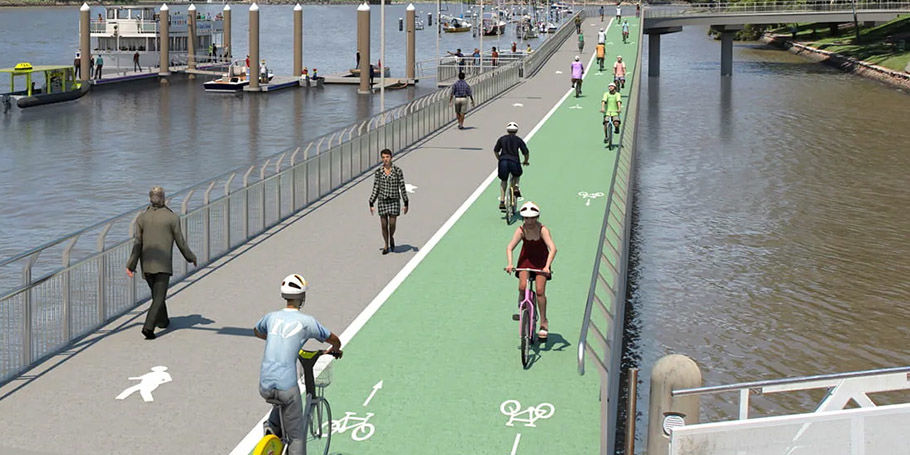How can coastlines prepare for climate change?

Get in touch with our team
Throughout human history, coastal cities and their surrounding areas have been vital hubs of the global economy, benefitting from their proximity to the sea, becoming key nodes of global trade and communication.
However, as climate change reshapes our coastlines, local populations face significant environmental, economic, and social challenges. Rising sea levels, stronger storms, and coastal erosion are pressing issues that require immediate action. So, how should coastal communities prepare for and respond to the impacts of climate change?
Here are six ways that we can prepare and strengthen our changing city coastlines:
1. Revitalise and adapt the urban coastline
Many coastal cities are aware of the risks and taking action to prioritise resilience. At Hunter's Point South in New York City, we have carried out successful sustainable waterfront development that works with nature to protect against the growing threats of flooding, extreme rainfall and sea level rise. This once abandoned industrial area has been revitalised for the community while strengthening its defences against flooding.
The park has been designed to serve as a prototype for sustainable urban ecology with a design that anticipates future flood patterns of the East River, with various sustainable features including bioswales, streetside stormwater planters, porous surfaces and the separation of the previously combined storm-sanitary sewer system. This scheme demonstrates that building resilience to climate threats presents valuable opportunities for wider urban/coastal regeneration.
Watch our 2024 Blue Horizons film, which explains how Hunter's Point South achieved a new level of resilience and regeneration:

2. Reimagine critical port and maritime infrastructure
Climate action is shaping the future of maritime transport. Ports are at the heart of this challenge. All country’s ports are essential hubs for economic activity, connecting people and communities to 80% of global trade and acting as a catalyst for development and thriving communities.
With spiralling costs due to climate change, ensuring future commercial viability and resilience of ports requires a different mindset. A fresh approach to port resilience can help ensure they remain pivotal to national economic security and the backbone of thriving coastal communities. Resilience is at the core of this, and taking a whole systems approach is essential to achieving that transformation.
To gain a better understanding of the issues shaping port resilience, learn more about our coastal resilience services.

3. Invest in preparation to unlock economic potential
Small coastal towns, already at risk from climate change due to rising sea levels and severe storms, often face the extra challenge of securing investment to implement measures to regenerate their communities. However, Porthcawl in Wales, UK successfully addressed the problem with a sensitive risk-based design approach. The Sandy Bay project manages coastal risk, safeguards a historic breakwater, restores sand dune habitat, and revitalises the seaside promenade. In addition to protecting over 700 properties from flooding and providing essential amenities, it will also be the catalyst for significant regional regeneration.
Learn more about our work with Porthcawl.
4. Protect vulnerable island nations
Sea level rise in areas of the Pacific Ocean is currently four times the global average. Small island developing states (SIDS) are on the front line of global climate change and feel the impacts very directly. Many atolls, homes to thousands, are less than 5m above sea level. A changing climate will have a significant impact on the local communities, affecting their physical environment, customs and culture.
We have been developing climate resilience approaches to help these communities in pragmatic and cost-effective ways.
Learn more about our assessments of climate and disaster risk for Tongatapu.
5. Prioritise nature-based solutions
Safeguarding communities doesn’t just mean building physical barriers. In many of the responses and interventions mentioned above, there are significant opportunities to use nature-based solutions.
This approach to coastal protection offers a wealth of important secondary benefits. It promotes biodiversity, creates desirable outdoor public spaces and limits the carbon emissions associated with implementing new resilience measures. This approach helps to tackle both the climate and the nature emergency.
- Learn more about nature-based solutions and coastal protection: Protecting coastlines and communities
- Learn more about NatureInsight – our digital analytics tool that identifies nature-based solutions to local flood risks.
6. Manage too much, or too little, water
In coastal cities, sea level rise and storm surges present growing risks to existing communities and infrastructure. Through interventions such as the City Water Resilience Approach, we can help cities respond to these challenges. This tool enables clients to systematically assess their current resilience, before developing action plans to tackle the issues identified.
In Cape Town, South Africa, we created a city characterisation report and water resilience profile using the City Water Resilience Approach, which highlighted opportunities for nature-based solutions, identifying sustainable funding systems and collaborating across the full supply chain to ensure that the area’s water resources are efficiently allocated.
Our Global Sponge Cities Snapshot also explores the natural ‘sponginess’ of cities around the world, to help them adopt nature-based solutions in the face of increasingly heavy rainfall and other climate-related water issues.
Explore related digital solutions:
Get in touch with us
If you'd like to speak to one of our cities experts about any of the issues raised on this page, or a potential collaboration, then please get in touch.



